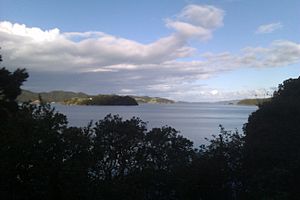Whangaruru facts for kids
Quick facts for kids
Whangaruru
|
|
|---|---|
 |
|
| Country | New Zealand |
| Region | Northland Region |
| District | Whangarei District |
| Ward | Hikurangi-Coastal Ward |
| Area | |
| • Total | 2.03 km2 (0.78 sq mi) |
| Population
(June 2023)
|
|
| • Total | 200 |
| • Density | 99/km2 (260/sq mi) |
Whangaruru is a small community and a beautiful harbour located on the east coast of Northland, New Zealand. It's a peaceful rural area.
To the south of Whangaruru, you'll find places like Mokau, Helena Bay, and the larger towns of Hikurangi and Whangārei. If you head northwest, you'll reach the famous Bay of Islands.
The Whangaruru area includes a few small villages: Punaruku, which is west of the harbour, and two areas simply called Whangaruru, one north and one east of the harbour.
The name "Whangaruru" has a cool story! It's said that a person named Puhimoanariki was sailing along the coast. He was looking for a safe place to hide from bad weather. When he found this harbour, it offered him great shelter. That's why "Whangaruru" means "sheltered harbour" in the Māori-language. It's even similar to "Honolulu" in the Hawaiian language!
Contents
Marae: Meeting Places
The Ngātiwai people, specifically the hapū (sub-tribe) called Te Uri o Hikihiki, are the original people of Whangaruru.
This hapū has several important traditional meeting places, known as marae, in the Whangaruru and Punaruku areas. These include:
- Ngātiwai Marae, which also has the Ngāti Wai Soldiers' Memorial Hall.
- Ōtetao Reti Marae, with its Hoori Reti meeting house.
- Tuparehuia Marae.
In October 2020, the New Zealand Government helped upgrade two of these marae. They gave money to improve Ōtetao Reti Marae and Ngātiwai Marae. These projects also created jobs for people in the community.
Whangaruru's Population
Statistics New Zealand describes Ōakura-Whangaruru South as a rural settlement. This area covers about 2.03 square kilometres. As of 2018, it had an estimated population of about 150 people.
Ōakura-Whangaruru South Census Data
The Ōakura-Whangaruru South area had 159 people in the 2023 New Zealand census. This was an increase of 9 people since the 2018 census. There were slightly more females (81) than males (75). The average age was 61.5 years, which is older than the national average.
Most people identified as European (69.8%), and a good number also identified as Māori (35.8%). About 15.1% were Pasifika. English was spoken by most people (96.2%), and 11.3% also spoke the Māori language.
Many people in this area identified as Christian (47.2%). About 35.8% said they had no religion.
Whangaruru Area Population
The larger Whangaruru statistical area is much bigger, covering about 469 square kilometres. As of 2023, it had an estimated population of about 2,733 people.
In the 2023 New Zealand census, the Whangaruru statistical area had 2,733 people. This was an increase of 213 people since the 2018 census. The average age was 46.3 years.
Most people identified as European (77.7%), and a significant number also identified as Māori (38.4%). English was spoken by most people (97.3%), and 9.0% also spoke the Māori language.
About 30.7% of people identified as Christian. A larger group, 58.2%, said they had no religion.
Education in Whangaruru
There is one main school in the area:
- Whangaruru School is a primary school for students in years 1 to 8 (ages 5-13). It was started in 2005. It brought together students from three older schools: Punaruku, Ngaiotonga Valley, and Helena Bay Schools. The school is located where the old Punaruku School used to be.
There was also a secondary school called Te Kura Hourua ki Whangaruru. It was a special type of school that opened in 2014 but closed in 2016.

